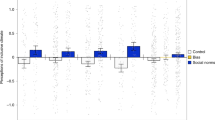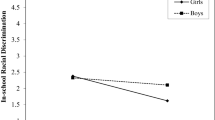Abstract
Literature on racially prejudiced stereotypes suggests that students’ academic self-concepts (ASC) can be damaged when a stereotype demeans the intelligence of their racial or ethnic group. There is little research on how students overcome this burden, but there is some evidence that the racial composition of friendship groups play a role. One argument suggests having racially diverse friends could help students see the inaccuracy of stereotypes and another points out that racially homogenous friends could collectively resist the stereotypes as a support group. In this study I analyze a nationally representative and racially diverse sample of United States adolescents to examine these hypotheses. After estimating multivariate regression models for four separate racial/ethnic groups (Asian, African-American, Hispanic, white), results show that although perceptions of prejudice do predict decreases in ASC for African-American students, racially homogenous friendship groups have the opposite effect which lends credibility to the support group hypothesis. In addition, racial diversity of friendship groups predicts decreased ASC for African-American students, suggesting diverse groups could make prejudice more salient. The implications for these findings include the reminder that prejudice is still a valid concern in American schools and that peers can be a significant source of racial tension and/or support. In terms of students’ ASC, it is important for educators to be aware of these social conditions and to continue to seek a better understanding of race relations in schools so that more students are not psychologically burdened by racial tension.
Similar content being viewed by others
References
Alexander C. N., Campbell E. Q. (1964) Peer influences on adolescent educational aspirations and attainments. American Sociological Review 29: 568–575
Antonio A. L. (2001) Diversity and the influence of friendship groups in college. The Review of Higher Education 25: 63–89
Antonio A. L. (2004) The influence of friendship groups on intellectual self-confidence and educational aspirations in college. The Journal of Higher Education 75: 446–471
Armenta B. E. (2010) Stereotype boost and stereotype threat effects: The moderating role of ethnic identification. Cultural Diversity and Ethnic Minority Psychology 16: 94–98
Awad G. (2007) The role of racial identity, academic self-concept, and self-esteem in the prediction of academic outcomes for African American students. Journal of Black Psychology 33: 188–207
Bachman J. G., O’Malley P. M. (1986) Self-concepts, self-esteem, and educational experiences: The frog pond revisited (again). Journal of Personality and Social Psychology 50: 35–46
Bankston C. L. III, Zhou M. (1995) Effects of minority language literacy on the academic achievement of Vietnamese youth in New Orleans. Sociology of Education 68: 1–17
Berg D. H., Klinger D. A. (2009) Gender differences in the relationship between academic self-concept and self-reported depressed mood in school children. Sex Roles 61: 501–509
Bissell-Havran J. M., Loken E. (2009) The role of friends in early adolescents’ academic self-competence and intrinsic value for math and English. Journal of Youth and Adolescence 38: 41–50
Blair S. L., Qian Z. (1998) Family and Asian students’ educational performance: A consideration of diversity. Journal of Family Issues 19: 355–374
Brown C. S., Leaper C. (2010) Latina and European American girls’ experiences with academic sexism and their self-concepts in mathematics and science during adolescence. Sex Roles 63: 860–870
Carreon G. P., Drake C., Barton A. C. (2005) The importance of presence: Immigrant parents’ school education experiences. American Education Research Journal 42: 465–498
Chantala, K. (2006). Guidelines for analyzing Add Health data. University of North Carolina Population Center, Chapel Hill. Retrieved June 15, 2010. http://www.cpc.unc.edu/projects/addhealth/design.
Cokley K. O., Chapman C. (2008) The roles of ethnic identity, anti-white attitudes, and academic self-concept in African American student achievement. Social Psychology of Education 11: 349–365
Cooley C. (1902) Human nature and the social order. Scribner’s, New York
Crosnoe R. (2000) Friendship in childhood and adolescence: The life course and new directions. Social Psychology Quarterly 63: 377–391
Cunningham G. B. (2008) Importance of friendship potential in reducing the negative effects of dissimilarity. The Journal of Social Psychology 148: 595–608
Delgado-Gaitain C. (1991) Involving parents in the schools: A process of empowerment. American Journal of Education 100: 20–46
Duncan O. D., Haller A. O., Portes A. (1968) Peer influences on aspirations: A reinterpretation. American Journal of Sociology 74: 119–137
Eccleston C. P., Smyth J. M., Lopoo L. M. (2010) Unraveling the race paradox of achievement and self-views. Social Psychology of Education 13: 1–18
Gurin P.Y., Dey E.L., Hurtado S., Gurin G. (2002) Diversity and higher education: Theory and impact on educational outcomes. Harvard Educational Review 72: 330–366
Guyll M., Madon S., Prieto L., Scherr K. C. (2010) The potential roles of self-fulfilling prophecies, stigma consciousness, and stereotype threat in linking Latino/a ethnicity and educational outcomes. Journal of Social Issues 66: 113–130
Haller A. O., Butterworth C. E. (1960) Peer influences on levels of occupational and educational aspiration. Social Forces 38: 289–295
Harris, K.M., Halpern C.T., Whitsel, E., Hussey, J., Tabor, J., Entzel, P., & Udry, J.R. (2009). The National Longitudinal Study of Adolescent Health: Research Design. http://www.cpc.unc.edu/projects/addhealth/design. Accessed 1 August, 2010.
Haynie D. (2001) Delinquent peers revisited: Does network structure matter?. American Journal of Sociology 106: 1013–1057
Kao G. (2000) Group images and possible selves among adolescents: Linking stereotypes to expectations by race and ethnicity. Sociological Forum 15: 407–430
Lareau A. (2003) Unequal childhoods: Class, race, and family life. University of California Press, Berkeley, CA
Little R. J. A., Rubin D. B. (2002) Statistical analysis with missing data. 2nd edn. Wiley Inter-Science, Hoboken
Marsh H. W., O’Mara A. (2008) Reciprocal effects between academic self-concept, self-esteem, achievement, and attainment over seven adolescent years: Unidimensional and multidimensional perspectives of self-concept. Personality and Social Psychology Bulletin 34: 542–552
Marsh H. W., Parker J. W. (1984) Determinants of student self-concept: Is it better to be a relatively large fish in a small pond even if you don’t learn to swim as well?. Journal of Personality and Social Psychology 47: 213–231
Mead G. H. (1934) Mind, self, and society: From the standpoint of a social behaviorist. University of Chicago Press, Chicago
Morgan S. L., Mehta J. D. (2004) Beyond the laboratory: Evaluating the survey evidence for the disidentification explanation of black-white differences in achievement. Sociology of Education 77: 82–101
Quillian L., Campbell M. E. (2003) Beyond black and white: The present and future of multiracial friendship segregation. American Sociological Review 68: 540–566
Roscigno V. J., Tomaskovich-Devey D., Crowley M. (2006) Education and the inequalities of place. Social Forces 84: 2121–2145
Schweinle A., Mims G. A. (2009) Mathematics self-efficacy: Stereotype threat versus resilience. Social Psychology of Education 12: 501–514
Shavelson R. J., Hubner J. J., Stanton G. C. (1976) Self-concept: Validation of construct interpretations. Review of Educational Research 46: 407–441
Shih M., Ambady N., Richeson J. A., Fujita K., Gray H. M. (2002) Stereotype performance boosts: The impact of self-relevance and the manner of stereotype activation. Journal of Personality and Social Psychology 83: 638–647
Snedker, K., Glynn, P. & Wang, C. (2002). Ordered/ordinal logistic regression with SAS and Stata. University of Washington. http://staff.washington.edu/glynn/olr.pdf. Accessed 4 August, 2010.
StataCorp (2009). STATA/MP 10.1 for windows. StataCorp LP, College Station.
Steele C. M., Aronson J. (1995) Stereotype threat and the intellectual test performance of African Americans. Journal of Personality and Social Psychology 69: 797–811
Steele C. M. (1997) A threat in the air: How stereotypes shape intellectual identity and performance. American Psychologist 52: 613–629
Tatum B. D. (1987) Assimilation blues: Black families in a white community. Greenwood Press, Westport
Tatum B. D. (1997) “Why are all the Black kids sitting together in the cafeteria?” and other conversations about race. Basic Books, New York
Author information
Authors and Affiliations
Corresponding author
Rights and permissions
About this article
Cite this article
Lehman, B. The impacts of friendship groups’ racial composition when perceptions of prejudice threaten students’ academic self-concept. Soc Psychol Educ 15, 411–425 (2012). https://doi.org/10.1007/s11218-012-9190-6
Received:
Accepted:
Published:
Issue Date:
DOI: https://doi.org/10.1007/s11218-012-9190-6




